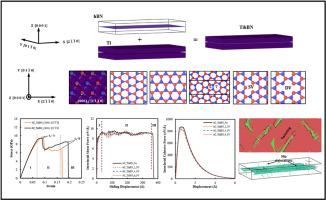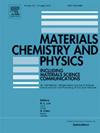研究用单晶和双晶 hBN 纳米片增强的钛基纳米复合材料的机械性能和断裂性能
IF 4.3
3区 材料科学
Q2 MATERIALS SCIENCE, MULTIDISCIPLINARY
引用次数: 0
摘要
石墨烯和氢溴萘基纳米复合材料的设计与制造正在将材料设计时代推向新的境界。本文利用 MD 模拟研究了用原始以及缺陷单晶和双晶 hBN 纳米片增强的钛基纳米复合材料的机械、断裂和界面行为。与原始钛基材料相比,纳米复合材料的破坏强度提高了 ∼ 100%。用单晶和双晶 hBN 纳米片增强钛基体可将纳米复合材料的破坏强度分别从 4.06 GPa 提高到 9.74 GPa 和 9.80 GPa。然而,空位缺陷(单空位或双空位)浓度(0-6%)的增加会导致纳米复合材料失效强度的连续降低。此外,用原始纳米片和缺陷纳米片增强的钛基体的变形机制分别受{101‾1} < 101‾2‾ >压缩孪晶和{101‾0} < 112‾0 >棱柱滑移位错的支配。此外,还分别采用了界面剪切强度和内聚强度的拉出速度和拉升速度模型来证实观察结果。本文章由计算机程序翻译,如有差异,请以英文原文为准。

Investigating the mechanical and fracture behaviour of Ti-based nanocomposites reinforced with single and bi-crystalline hBN nanosheets
The design and manufacturing of graphene and hBN-based nanocomposites is taking the era of material design to new horizons. The present article employs MD simulations to investigate the mechanical, fracture, and interfacial behaviour of the Ti-based nanocomposites reinforced with pristine as well as defective single and bi-crystalline hBN nanosheets. The nanocomposites exhibited over ∼100 % improvements in the failure strengths as compared to pristine Ti matrices. Reinforcement of the Ti matrices with single and bi-crystalline hBN nanosheets improved the failure strengths of the nanocomposites from 4.06 GPa to 9.74 GPa and 9.80 GPa, respectively. However, an increase in vacancy defect (Single or Di-vacancy) concentration (0–6%) resulted in a successive reduction of the failure strength of the nanocomposites. Moreover, the deformation mechanisms in Ti matrices reinforced with pristine and defective nanosheets were observed to be governed by {} < > compression twin and < > prismatic slip dislocations, respectively. Furthermore, the pull-out and pull-up velocities models of interfacial shear and cohesive strengths, respectively, were employed to confirm the observed results.
求助全文
通过发布文献求助,成功后即可免费获取论文全文。
去求助
来源期刊

Materials Chemistry and Physics
工程技术-材料科学:综合
CiteScore
8.70
自引率
4.30%
发文量
1515
审稿时长
69 days
期刊介绍:
Materials Chemistry and Physics is devoted to short communications, full-length research papers and feature articles on interrelationships among structure, properties, processing and performance of materials. The Editors welcome manuscripts on thin films, surface and interface science, materials degradation and reliability, metallurgy, semiconductors and optoelectronic materials, fine ceramics, magnetics, superconductors, specialty polymers, nano-materials and composite materials.
 求助内容:
求助内容: 应助结果提醒方式:
应助结果提醒方式:


